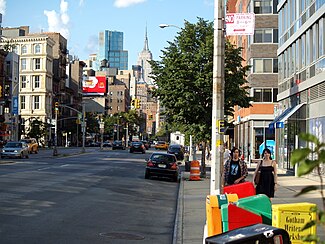
Back Bowery Catalan Bowery Czech Bowery German Bowery Spanish Bowery Basque بوری (نیویورک) Persian Bowery Finnish Bowery French Bowery ID Bowery (New York) Italian
 Looking north from Houston Street | |
| Former name(s) | Bowery Lane (prior to 1807) |
|---|---|
| Length | 1.6 km (0.99 mi) |
| South end | Chatham Square |
| North end | East 4th Street (continues as Cooper Square) |

The Bowery (/ˈbaʊəri/)[1][2] is a street and neighborhood in Lower Manhattan in New York City, United States. The street runs from Chatham Square at Park Row, Worth Street, and Mott Street in the south to Cooper Square at 4th Street in the north.[3] The eponymous neighborhood runs roughly from the Bowery east to Allen Street and First Avenue, and from Canal Street north to Cooper Square/East Fourth Street.[4][5][6] The neighborhood roughly overlaps with Little Australia. To the south is Chinatown, to the east are the Lower East Side and the East Village, and to the west are Little Italy and NoHo.[6][7] It has historically been considered a part of the Lower East Side of Manhattan.[8]
In the 17th century, the road branched off Broadway north of Fort Amsterdam at the tip of Manhattan to the homestead of Peter Stuyvesant, director-general of New Netherland. The street was known as Bowery Lane prior to 1807.[9] "Bowery" is an anglicization of the Dutch bouwerie, derived from an antiquated Dutch word for "farm": In the 17th century the area contained many large farms.[3]
The New York City Subway's Bowery station, serving the BMT Nassau Street Line (J and Z trains), is located close to the Bowery's intersection with Delancey and Kenmare Streets. There is a tunnel under the Bowery intended for use by a never-built subway extension.[10][11] The M103 bus runs on the entire Bowery.
- ^ "Bowery". Dictionary.com Unabridged (Online). n.d.
- ^ "Bowery" (US) and "Bowery". Lexico UK English Dictionary. Oxford University Press. Archived from the original on July 27, 2020.
- ^ a b Jackson, Kenneth L. "Bowery" in Jackson, Kenneth T., ed. (2010). The Encyclopedia of New York City (2nd ed.). New Haven: Yale University Press. ISBN 978-0-300-11465-2., p. 148
- ^ citidex.com 2006; Fodor's 1991
- ^ "Bowery" (Map). Google Maps. Retrieved August 14, 2018.
- ^ a b "Chapter 2: Land Use, Zoning, and Public Policy" (PDF).
- ^ Manhattan: City Council, Assembly, and State Senate (map)
- ^ Richard E. Ocejo (2014). Upscaling Downtown: From Bowery Saloons to Cocktail Bars in New York City. Princeton University Press. pp. 9, 16, 230. ISBN 9781400852635.
Historically, the Lower East Side and East Village neighborhoods and the Bowery area combined to form the 'Lower East Side' of Manhattan: between Fourteenth Street and the Manhattan and Brooklyn Bridges and between Broadway and the East River. ... Technically, Bowery ends at Fourth Street, where Cooper Square begins. Originally, Bowery ran to Union Square at Fourteenth Street, and served as the westernmost border for the historical Lower East Side. However, in 1849 wealthy residents of the Union Square area changed the name of their section of Bowery from St. Mark's Place to Fourteenth St. to Fourth Avenue, with Cooper Square (Fourth Street to St. Mark's Place) serving as a buffer zone, in an effort to dissociate it from the lowlier working-class and immigrant reputation of the Bowery (Anbinder 2001).
- ^ Brown, 1922
- ^ "Second Avenue Subway: Completed Portions, 1970s". www.nycsubway.org. Archived from the original on August 23, 2014. Retrieved March 27, 2018.
- ^ "Manhattan East Side Transit Alternatives (MESA)/Second Avenue Subway Summary Report" (PDF). Metropolitan Transportation Authority. Retrieved March 27, 2018.